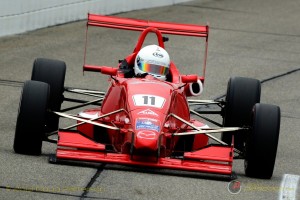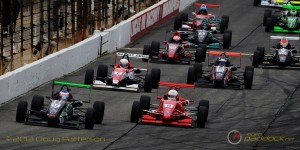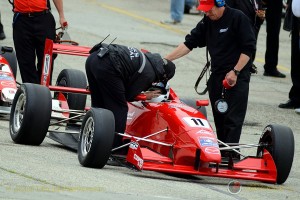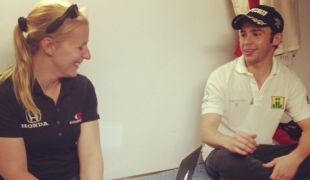Racer to Racer: Pippa Mann trades oval racing notes with USF2000 racer Danilo Estrela
IndyCar, IndyCar commentary — By More Front Wing Staff on August 13, 2013 11:08 amIn this More Front Wing special feature, IndyCar racer Pippa Mann sits down with Danilo Estrela, a rookie driving in the USF2000 series with Belardi Auto Racing, to compare notes on what it’s like for a career road racer to take those first race laps in an open-wheel car on an oval. Their conclusion: it’s harder than you think!
—
As someone who grew up racing in Europe racing on road courses and then transitioned to racing on ovals, watching Jessica Bean make the transition the opposite way and undertake her first-ever road races was a very interesting experience for me and one I was happy to share with More Front Wing readers. From Jessica’s experience, it is obvious that trying to go road racing when you’ve only turned left your whole life is very hard.
 As you may already know, my first experiences on an oval came in Indy Lights in 2009 and 2010, and subsequently all of my IndyCar experience has so far come only on ovals despite growing up racing on road courses. I thought it would be interesting to speak to someone else on the ladder who’s making the same transition that I did and just starting to learn about oval racing for the first time.
As you may already know, my first experiences on an oval came in Indy Lights in 2009 and 2010, and subsequently all of my IndyCar experience has so far come only on ovals despite growing up racing on road courses. I thought it would be interesting to speak to someone else on the ladder who’s making the same transition that I did and just starting to learn about oval racing for the first time.
IndyCar put me in touch with Belardi Auto Racing and one of their USF2000 drivers, Danilo Estrela. At Mid-Ohio we got together on Friday evening after he was finished on track for the day, and I got his take on what it’s like to learn about turning in circles.
Pippa Mann – What type of racing did you grow up doing in Brazil, and grow up watching in Brazil?
Danilo Estrela – I didn’t start racing until I was 14. I always watched racing on TV: F1 and IndyCar, and the Brazilian stock cars too; that’s big down there. And then, one day as a present my Dad gave me a PlayStation 2 and a Notebook — both worth quite a lot of money at the time in Brazil. I had a friend who had a go kart, and I swapped him the PlayStation 2 and the Notebook for his go kart! It was a very old kart, so I’m not sure it was a nice exchange…
PM – You traded your PlayStation and the Notebook for your first go kart?!
DE – Yeah. Then I went home and my Dad, he asked where the PlayStation and Notebook were, and I told him I’d traded them for a go kart. He told me I was crazy! But once he calmed down, he was fine. We went to pick it up, but it was broken. So, then we had to hire a mechanic to help us make it work. I started to drive it, and to race it, just for fun. And after a year, I was Vice Champion in my state.
PM – And at that time, you’d only raced on road and street courses, right?
DE – Yes. And that’s how I started in racing.
PM – So, what was the first oval race you ever remember seeing on TV? When did you first really become aware of oval racing? Was it the Indy 500?
DE – It wasn’t the Indy 500. I think I remember it was Homestead when I first saw oval racing on TV. I was about 14, the same age I started racing.
PM – And what was the first oval race you ever saw live?
DE – Actually it was just this year, the Indy 500.
PM – What was your biggest impression then on seeing it live for the first time compared to only having watched oval racing on TV until this point?
DE – Here’s the thing with TV: for me, it kind of lies sometimes with the speed of the car. When I was actually at Indianapolis Motor Speedway for the Indy 500 and I saw this speed in real life, I was like, “this is mad!” It was really fast, so fast, and on TV you know it’s fast but it’s not like seeing someone heading into turn one at Indianapolis at that speed and thinking “this is not gonna happen” and then you look again and they just made it a normal corner. So, I think in real life it creates a much better impression.
PM – You mentioned that Homestead was the first oval you saw on TV. Have you ever been there?
DE – Yeah, I’ve been there, but on the road course.
PM – What did you think when you first saw how high the banks actually were compared to how they look on TV?
DE – At first I felt like it looked so high and steep that the car might fall down! I have been to Daytona, too, for the 24 hours, and the banking there is even bigger. It was so huge, and just seeing the Daytona Prototypes going through there was quite something.
 PM – So, what about the first time you ever got to drive on an oval — when and where was it?
PM – So, what about the first time you ever got to drive on an oval — when and where was it?
DE – It was at Lucas Oil Raceway at the official test day for our race there this year. I didn’t get to do any other test there or any private test on an oval somewhere. That was the first time I got to run on any oval, nothing before.
PM – How did you feel when you arrived there that morning and knew you were going to be driving on an oval for the first time? What was going through your head?
DE – We actually had a really good test here at Mid-Ohio, but everyone kept saying, “ooh, next you’re going to an oval, and you’ve never driven one.” The team manager was actually a little bit freaked out. He wanted me to have gone to a test because everyone else had already done this, but we didn’t have it in the budget, I couldn’t do it. To be honest, though, I was not that nervous. I said, “It’s just turning left. It’s going to be easy.”
PM – [Laughs]. The first time when I showed up at Homestead for my first oval test and saw how high the banks were and what I would be driving on, I basically just had a stream of expletives. I had never seen a high-banked track before apart from on TV, and my only repeatable thought was “You have got to be kidding me!” So, I’m amazed you were taking it all so calmly.
DE – Yup, and I was thinking all I had to do was turn left, not be aggressive with the car, stay on the throttle. It couldn’t be that hard. And then my first few laps there, I was like, “okay, this is harder than road racing!” I couldn’t believe how wrong I had been!
PM – That was actually going to be one of my questions — whether it was easier or harder than you thought it would be.
DE – It was way harder than I expected. Way harder. I was like, dude, seriously? This is making road racing and road course driving seem like a joke, it’s so much easier than this!
PM – What about the car setup? In an Indy Lights car or an IndyCar they are set up to turn left pretty hard, which made me feel like the car had bent suspension when I was trying to learn how to drive on the oval for the first time.
DE – It’s the same in a USF2000 car, except at Lucas Oil because the lap is so short and the corners are so tight, and with so little banking maybe it’s even worse. Going down the straight, I felt like I was using more energy to try and keep the car going straight than I was turning it in the corners. But my biggest challenge was my footwork in the car. At Lucas Oil in the USF2000 car, you are actually braking a little into the corners and using both pedals at the same time, and you have to be really, really smooth with both pedals all the time. Learning how to manage the weight transfer in the car and how my footwork could affect that — that was definitely the biggest challenge for me.
PM – Tell me about the first time you experienced “dirty air” behind another car. Do you feel that in USF2000?
DE – Oh yes, oh yes, big time! The first time I got in dirty air was the second session. For the first session they split us into two groups, and I didn’t want to run too close to anyone. However, then the sessions were together, so there were 30 cars on track at once. It felt like two laps, traffic, two laps, traffic, and the first time I really got in that dirty air I was just there turning the wheel and turning the wheel, and the car just would not turn at all! I had this much steering in the car [Danilo shows the amount of lock with his hands at this point; you’ll have to use your imaginations to picture the scene], but it just kept washing to the outside. Then I got some clean air again and the front started to grip again, and I started to work it out. I felt like I was planning three or four laps ahead to try and work out how to overtake the car in front of me.
PM – How long did it take you to start feeling comfortable in that type of situation around the other cars? Did it come pretty quickly, or did it take a while?
DE – That part I felt like I started to get the hang of pretty quickly. I think figuring out to race that oval in the dirty air was easier than I thought it would be. For me, the biggest challenge after [being smooth with] my feet was setting up the car. You have to be able to give your engineer good feedback on the oval to have a good car, and you have to have a good car to go fast. I definitely struggled with that.
PM – How was it having a spotter for the first time? Was it a distraction at first to have someone constantly talking to you, constantly in your ear?
DE – I actually felt very comfortable with that. It gave me a nice sense of security. It’s nice to know what’s going on around me so that I can concentrate on what I’m doing instead of having to watch everyone else. Brian Belardi was my spotter for the first time, and then Stef Wilson started spotting for me. Stef was able to give me tips about what it looked like the car needed because he could see so much watching from up high on the outside like that. That helped a lot!
 PM – So, you guys do single-car qualifying on the ovals in USF2000, right?
PM – So, you guys do single-car qualifying on the ovals in USF2000, right?
DE – Yup, the same way.
PM – Did you end up trimming out the car and feel like you were really pushing the edge? [Gestures with thumb under chin.]
DE – For qualifying, we actually put a lot more wing in the car. You need so much downforce to try and be fast, but in the race you take some out so that you’re a little faster just on the straight.
PM – So, it’s actually the opposite way round to IndyCars and Indy Lights cars when qualifying on an oval. Did it still feel like you were going out there and just trying to be really brave for those two laps, though?
DE – Yeah, I felt like that for sure, and it was actually one of my mistakes during the weekend. My first lap I was really quick, then my second lap I was just too aggressive. I pushed too hard, and I lost like three or four tenths. That’s a lot! Losing that much time on a short oval is like losing three seconds on a road course.
PM – After everything you’ve done so far, you’re now at the start of your first-ever oval race. You’re used to doing rolling starts on road and street courses, but how different was it doing the same type of rolling start but now on an oval? How daunting was it going into turn 1 surrounded by all those other cars when you were doing this for the first time?
DE – The start was very interesting, starting with the pole being on the outside! I always thought if I had the pole I want to be on the inside because then I have the line, so that was very different to me. Then you start almost still on the back straight going into turn 3. Also, when you have a start in road racing you just have to get through the first few corners okay and then normally everything is fine, everything settles down. Not there! The cars were running side by side for four or five laps, and I didn’t know when it was going to stop and the rest of the race was going to start! That felt like a long time.
PM – What was your favorite part about the whole experience, or your least favorite part?
DE – My favorite part was that we didn’t do that badly. I wish I could have done better, but 4th place for my first-ever race on an oval — when other people had tested and things, too — I was pretty happy with that.
PM – Yes, you’ve got to be pretty happy with a top five finish!
DE – I also really liked that it’s just high-speed corners and you have to be really brave there. The thing I didn’t like as much — it’s physical. It’s really hard on you. Not that I don’t work in the gym or anything, but it’s hard in a different way. It’s easy to get a cramp in your right leg, and I was starting to get sore in my right shoulder and my neck a little, too. The second thing I didn’t like is how much it depends on the car. You have to be able to give good feedback and help the engineer give you a good car because you can only go as fast as your car.
PM – Now, with the win in Toronto under your belt, do you think the confidence from that will actually carry over and help you do even better next time you get to run an oval?
DE – Actually, I would say the opposite thing happened. I started to feel like I couldn’t do better in road racing, but the oval taught me how to be smooth — with the pedals, with the steering wheel, with everything, especially with the high-speed corners. So, I think it really helped me to move forwards. Then, looking to my next oval, I think now I understand how to set up the car better, and I think that will help me. But I think the oval played a big, big part in helping me understand the car better.
PM – Is there anything that I’ve missed about the experience, that you want to share or you want people to know about driving on an oval?
DE – I think the thing is it’s just amazingly hard. In Europe and South America there are a lot of people who don’t respect the ovals that much. I would tell them to go and get some more information because thinking this is easy is a big mistake! In many ways it’s way tougher than road racing. For a while in the first session, I thought to myself, “Man, I can’t make it to IndyCar because I don’t know how to do this, I don’t understand this!” I’ve never had that before. That’s how tough it is. Then, once you get going, you just start liking it, liking the challenge. But it’s tough mentally, too — definitely a lot tougher mentally than road racing. I think that’s what I want people to know and to understand. It’s much harder than you think!
PM – One final question. I work with an organization called Glass Hammer Racing, and we’re supporting and helping a dirt racer called Jessica Bean as she makes her transition to road racing for the first time. Have you ever been to a dirt track race here in the US yet to watch the midgets and sprint cars run?
DE – No, I haven’t! I want to go, though. Maybe we will have to organize it. I really like to drift, going sideways. I haven’t seen it yet, but I have heard about it. I would really like to try one of those…
Tags: Danilo Estrela, Pippa Mann







